Mobile 25 - Dragable, Dear, Thin, Trendy
01. Aug. 2007
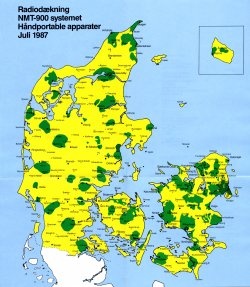
Although the mobile telephone was a status symbol in the late i 1980's, it was far from everywhere in Denmark that it was possible to use it. The green areas indicate where the covering was relatively good.
Today mobile phones have become an indispensable aid in our everyday life. Besides making friends, maintaining networks, and planning the normal run of things it is used for playing games, taking pictures, listening to music and radio, surfing on the internet and soon it will also for watching TV. The mobile phone is such an obvious part of our life that we do not bear in mind that it already has a history. And it is something of that history Post & Tele Museum wants to show at the Mobile 25 exhibition.
When the Car Phone became Mobile
Already from the mid 1950's it was possible to make phone calls and be on the road at the same time. The early car phones were installed in the car, and the battery weighing in the order of 40 kg filled up most of the boot. The first car phones were truly the dinosaurs of mobile telephony. The price level of a car phone installation at that time was equal to the price of a small car so it was definitely not within the reach of everyone to own a car phone.

A yuppie in a café in the late 1980's. To own a Mobira Cityman was a symbol of an unfailing sense of style, sucees, and not least prosperity. Price: DKK 43,.000.
Photo: De danske Televirksomheder.
Usually the installation of such a monstrosity had a commercial background. The car phones functioned as radio transmitters/receivers. To obtain connection you had to call an operator who then established connection to the requested number. As a matter of fact all other car phone owners could listen in to the conversation if they just tuned in their car phone on the same frequency.
In 1982, Nordisk Mobil Telefoni (NMT) [Nordic Mobile Telephony] was established in Denmark. It was the first international and automatic mobile phone network in the world. The network which functioned until 2002 was created in collaboration between Denmark, Finland, Norway, and Sweden, as well as the Netherlands, Switzerland, and some Eastern European countries.
The NMT network really laid the groundwork for making the car phone mobile because now the users could contact each other directly and not least: Take the telephone out of the car.
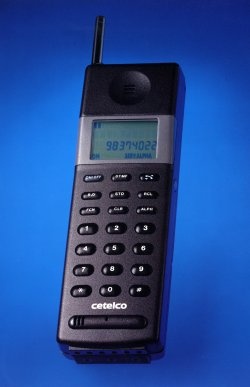
Denmark was in front when it came to development of mobile telephones during the 1980's. Cetelco Highflex was a Danish produced mobile telephone.
Photo from a sales brochure.
And in the 1980's mobile phone producers like AP Radio and Storno A/S in the Copenhagen area and Dancall and Cetelco in Northern Jutland gave rise to a bright future for the mobile phone industry in Denmark.
The Danish mobile phone adventure is represented in the exhibition by the technical wonders of the time when you really got something for your money: A Dancall 7000 weighed as much as 54 Iphones of our time and cost DKK 19,200 which is equal to about DKK 36,000 today.
Competition proved to be too keen and eventually all producers in Denmark had to close down or were bought up by other companies. However, this did not put any damper on the customers' increasing interest in mobile telephony. In the exhibition their stories are being told by 12 fictitious persons from selected periods of the instrument's first 25 years in Denmark. Here you can meet the entire register from the yuppie of the 1980's with his unfailing sense of style and his brick heavy mobile phone to the teenager of our time with her always turned on, always accessible mobile phone.
Mobile Phones at the Festivals of Life?
The mobile phone has acquired an important place in our life and it is hard to remember how we ever managed without it, but it has not become a motif of our holiday and family photos. Or has it?
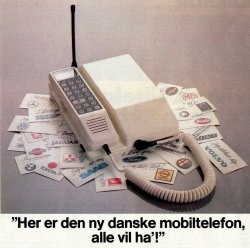
Advertisement for Cetelco mobile telephone.
The Magazine "Motorbladet" 1987.
In connection with the special exhibition we are also collecting mobile phones, anecdotes, memories, and photos. Has the mobile phone found its way to the festival table during the confirmation, is it lying in the rollator whilst grandma is visiting the senior centre, or is little Emil playing games in the lavatory? We think so, but the big question is: Is it also on photos? We hope that the museum's visitors and readers will help us answer the question. We are not looking for artificially arranged photos in our honour, but if your album contains photos featuring the mobile phone from the last 25 year, we would very much like to include a copy in the museum's collections.
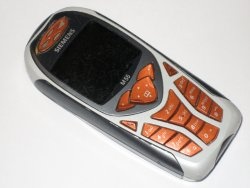
It was not only the visitors of the Roskilde Festival who had enough of rain in 2007; This Siemens mobile phone did not like the muddy puddles either.
Muddy Mobile Phone
In the last volume of MuseumsPosten we asked for old mobile phones, and the result has not failed to materialize. We received old as well as new mobile phones; many funny models and stories, among them for instance the story about an old Siemens mobile phone whose owner had inherited it from a female friend in 2005 when he was 31 years old and his friends had grown tired of not being able to get in touch with him. It was already worn when he got it, it quickly ran out of power, and it switched off for no apparent reason during conversations. It came to a sad end at the Roskilde Festival this year when it was dropped in a muddy puddle. Since then the owner has inherited another old mobile phone.
The collected mobile phones will be shown at the special exhibition, and as the collection proceeds, the exhibition will continuously grow. The collection will go on until December 2007.
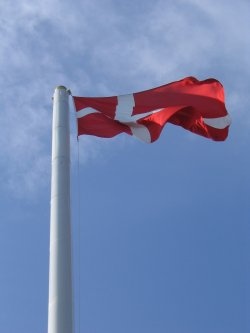
This is NOT a flagpole - or perhaps it is! In order to reduce the dominance of the mobile phone antennas in the townscape, creative ways to hide them are devised. Here a flagpole has become an antenna-bearer. Photo: TDC A/S.
Contact
Regarding collection of mobile phones, memories, and photos: Please contact registrar Malene Iwersen on tel. no. 33 41 09 00 or send an e-mail to museum@ptt-museum.dk.
Mobile Phone Website
Concurrently with the opening of the exhibition the museum is starting up a new website, www.mobil25.dk. Here you can follow the history of the mobile phone via a time line as a memory card containing more detailed information. The website is designed and programmed by Lasse Middelbo Outzen.
The Mobile25 exhibition can be seen on the Balcony from 28th August 2007 to 13th January 2008.
This article may be copied or quoted with MuseumsPosten, Post & Tele Museum as source.
Comment this article
Only serious and factual comments will be published.